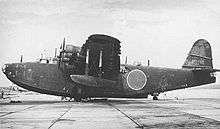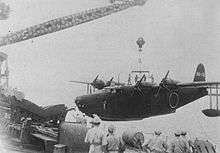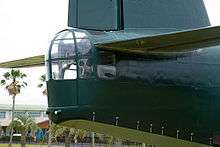Kawanishi H8K
| H8K | |
|---|---|
_flying_boat.jpg) | |
| Kawanishi H8K2 at Kanoya museum, Japan | |
| Role | Four engine long-range Flying boat |
| Manufacturer | Kawanishi |
| Designer | Shizuo Kikuhara |
| First flight | January 1941 |
| Introduction | February 1942 |
| Retired | 1945 |
| Primary user | IJN Air Service |
| Produced | 1941-1945 |
| Number built | 167 131 of Type 2 Flying boat 36 of Seiku |
|
| |
The Kawanishi H8K (二式飛行艇, Nishiki Hikōtei, Type 2 Flying Boat. Commonly called as 二式大型飛行艇 Nishiki Ōgata Hikōtei, 二式大艇 Nishiki Daitei or Nishiki Taitei, Type 2 Large-sized Flying Boat) was an Imperial Japanese Navy flying boat used during World War II for maritime patrol duties. The Allied reporting name for the type was "Emily".
Design and development
At the same time the type's predecessor, the Kawanishi H6K, was going into service in 1938 the Navy ordered the development of a larger, longer-ranged patrol aircraft under the designation Navy Experimental 13-Shi Large-size Flying Boat.[1][2] The result was a large, shoulder-winged design that is widely regarded as the best flying boat of the war.[3][4][5] Despite this, initial development was troublesome, with the prototype displaying terrible handling on the water. Deepening of the hull, redesigning of the planing bottom and the addition of spray strips under the nose rectified this[6] Two further prototypes— actually pre-production aircraft— joined the development program in December 1941.
The IJNAF accepted the first production version as the H8K1, Navy Type 2 Flying Boat, Model 11, of which 14 would be built.
The improved H8K2 variant soon appeared, and its extremely heavy defensive armament earned it deep respect among Allied aircrews.[7] The H8K2 was an upgrade over the H8K1, having more powerful engines, slightly revised armament, and an increase in fuel capacity. This was to be the definitive variant, with 112 produced.
36 examples of a dedicated transport version, the H8K2-L, were also built, capable of carrying 62 troops. This aircraft was also known as Seiku (晴空, "Clear Sky"). The side defensive blisters, ventral defensive hatch, and dorsal turret were discarded. To increase the available space within the aircraft, its hull tanks were removed, thus reducing its range.
Operational history

The H8K entered production in 1941 and first saw operational use on the night of 4 March 1942 in a second raid on Pearl Harbor. Since the target lay out of range for the flying boats, this audacious plan involved a refuelling by submarine at French Frigate Shoals, some 900 km (560 mi) north-west of Hawaii, en route. Two planes from the Yokohama Kōkūtai (Naval Air Corps)[8] attempted to bomb Pearl Harbor, but, due to poor visibility, did not accomplish any significant damage.[9]
Six days after the second Pearl harbor raid one of the Emilys was sent on a daylight photo-recon mission of Midway Atoll. It was intercepted by radar directed Brewster Buffalo fighters of Marine Corps squadron VMF-221 and shot down. All aboard were killed including Lt. Hashizume Hisao, the lead pilot of the second Pearl Harbor raid.
H8K2s were used on a wide range of patrol, reconnaissance, bombing, and transport missions throughout the Pacific war. The H8K2 was given the Allied code name "Emily".
Variants



- H8K1 Experimental Type 13 Large-sized Flying boat (13試大型飛行艇 13-Shi Ōgata Hikōtei)
- One prototype and four supplementary prototypes. Prototype was mounted Mitsubishi Mk4A Kasei 11 engines, supplementary prototype was mounted Mitsubishi MK4B Kasei 12 engines. Supplementary prototypes were renamed Type 2 Flying Boat Model 11 on 5 February 1942. Prototype was rebuilt to H8K1-L in November 1943.
- H8K1 Type 2 Flying boat, Model 11 (二式飛行艇11型 Nishiki Hikōtei 11-gata)
- Developed on 5 February 1942. First operative model of series, 12 produced. Mounted Mitsubishi MK4B Kasei 12 engines.
- H8K1-L Type 2 Transport Flying Boat (二式輸送艇 Nishiki Yusōtei)
- Rebuilt from H8K1 prototype. Fitted augment exhausts. Up to 41 passengers.
- H8K2 Type 2 Flying boat, Model 12 (二式飛行艇12型 Nishiki Hikōtei 12-gata)
- Developed on 26 June 1943. Mounted Mitsubishi MK4Q Kasei 22 engines and improved tail gun turret. Latter batch was equipped with Air-to-Surface-Vessel search radar, and removed side gun blisters. 112 produced.[13]
- H8K2-L Seikū ("Clear Sky"), Model 32 (晴空32型 Seikū 32-gata)
- Transport version of H8K2. Initial named Type 2 Transport Flying Boat, Model 32. Armaments were 1 × forward-firing 20 mm cannon and 1 × rearward-firing 13 mm machine gun. Up to 64 passengers.
- H8K3 Provisional name Type 2 Flying Boat, Model 22 (仮称二式飛行艇22型 Kashō Nishiki Hikōtei 22-gata)
- Experimental version, H8K2 modified. Equipped with retractable floats in wingtips, fowler flaps, sliding hatch side gun locations in place of the blisters and a retractable dorsal turret, all in an effort to increase speed, two prototypes only (work number 596 and 597).
- H8K4 Provisional name Type 2 Flying Boat, Model 23 (仮称二式飛行艇23型 Kashō Nishiki Hikōtei 23-gata)
- H8K3 re-engined with 1,825 hp MK4T Mitsubishi Kasei 25b engines, two converted from H8K3.
- H8K4-L Provisional name Seikū, Model 33 (仮称晴空33型 Kashō Seikū 33-gata)
- Transport version of H8K4. Only a project, because all H8K4s were lost in March 1945.
- G9K
- Proposed land-based attack bomber variant, only a project.
Operators


- Imperial Japanese Navy Air Service
- Saeki Kōkutai
- Sasebo Kōkutai
- Takuma Kōkutai
- Yokohama Kōkutai
- Yokosuka Kōkutai
- 14th Kōkutai
- 801st Kōkutai
- 802nd Kōkutai
- 851st Kōkutai
- 901st Kōkutai
- 902nd Kōkutai
- 951st Kōkutai
- 1001st Kōkutai
- 1021st Kōkutai
- 1081st Kōkutai
- Miscellaneous
- Kamikaze
- Azusa group (picked from 801st Kōkutai, guidance only)
Survivors

Four aircraft survived until the end of the war. One of these, an H8K2 (work number 426), was captured by U.S. forces at the end of the war and was evaluated before being eventually returned to Japan in 1979. It was on display at Tokyo's Museum of Maritime Science until 2004, when it was moved to Kanoya Air Base in Kagoshima.
The submerged remains of an H8K can be found off the west coast of Saipan, where it is a popular scuba diving attraction known erroneously as the "B-29", or the "Emily". Another wrecked H8K lies in Chuuk Lagoon, Chuuk, in Micronesia. This aircraft is located off the south-western end of Dublon Island.
Specifications (Kawanishi H8K2)

Data from Jane’s Fighting Aircraft of World War II[15]
General characteristics
- Crew: 10
- Length: 28.15 m (92 ft 4 in)
- Wingspan: 38.00 m (124 ft 8 in)
- Height: 9.15 m (30 ft)
- Wing area: 160 m² (1,721 ft²)
- Empty weight: 18,380 kg (40,436 lb)
- Loaded weight: 24,500 kg (53,900 lb)
- Max. takeoff weight: 32,500 kg (71,500 lb)
- Powerplant: 4 × Mitsubishi Kasei 22 radial engines, 1,380 kW (1,850 hp) each
Performance
- Maximum speed: 465 km/h (290 mph)
- Range: 7,150 km (4,440 mi)
- Service ceiling: 8,760 m (28,740 ft)
- Rate of climb: 8.1 m/s (1,600 ft/min)
- Wing loading: 153 kg/m² (31 lb/ft²)
- Power/mass: 0.22 kW/kg (0.14 hp/lb

)
Armament
- Guns:
- 5× 20 mm Type 99 cannon (one each in bow, dorsal, and tail turrets, plus one each in two waist blisters)
- 5× 7.7 mm (.303 in) Type 92 machine guns in fuselage hatches
- Bombs: 2× 800 kg (1,764 lb) torpedoes or 2,000 kg (4,410 lb) of bombs or depth charges
Avionics
See also
- Aircraft of comparable role, configuration and era
- Related lists
- List of aircraft of World War II
- List of seaplanes and flying boats
- List of military aircraft of Japan
References
- Notes
- ↑ Francillon 1979, pp. 307, 547.
- ↑ Richards 1972, p. 242.
- ↑ Green 1972, p. 131.
- ↑ Van der Klaauw, p. 86.
- ↑ Francillon 1979, p. 312.
- ↑ Richards 1972, p. 244.
- ↑ Francillon 1979, p. 310.
- ↑ Richards 1972, pp. 250–251.
- ↑ Raymer 1996, pp. 96–98.
- ↑ Famous Airplanes of the World (1994), pp. 19–22.
- 1 2 The Maru Mechanic (1979), pp. 71–73.
- ↑ Model Art (1999), pp. 61–69.
- ↑ Richards 1972, p. 262.
- ↑ Famous Airplanes of the World (1994), each pages.
- ↑ Bridgeman 1946, pp. 185–186.
- Bibliography
- Bridgeman, Leonard. "The Kawanishi H8K2 “Emily”" Jane’s Fighting Aircraft of World War II. London: Studio, 1946. ISBN 978-1-85170-493-4.
- Francillon, Ph.D., René J. Japanese Aircraft of the Pacific War. London: Putnam & Company, 1970 (2nd edition 1979). ISBN 978-0-370-30251-5.
- Green, William. Warplanes of the Second World War, Volume Five: Flying Boats. London: Macdonald & Co.(Publishers) Ltd., 1962. ISBN 978-0-356-01449-4.
- Raymer, E.C. Descent Into Darkness. Presidio Press, 1996. ISBN 0-89141-589-0.
- Richards, M.C. "Kawanishi 4-Motor Flying-Boats (H6K 'Mavis' and H8K 'Emily')". Aircraft in Profile Volume 11. Windsor, Berkshire, UK: Profile Publications Ltd., 1972.
- Van der Klaauw, Bart. Water- en Transportviegtuigen Wereldoorlog II (in Dutch). Alkmaar, the Netherlands: Uitgeverij de Alk. ISBN 978-90-6013-677-5.
- Famous Airplanes of the World, No. 49 Type 2 Flying Boat, Bunrindō (Japan), November 1994.
- The Maru Mechanic, No. 19 Feature, Type 2 Flying Boat, Ushio Shobō (Japan), November 1979.
- Model Art No. 541, Special issue Type 2 Flying Boat and Imperial Japanese Navy Flying Boats, Model Art Co. Ltd., July 1999.
External links
| Wikimedia Commons has media related to Kawanishi H8K. |